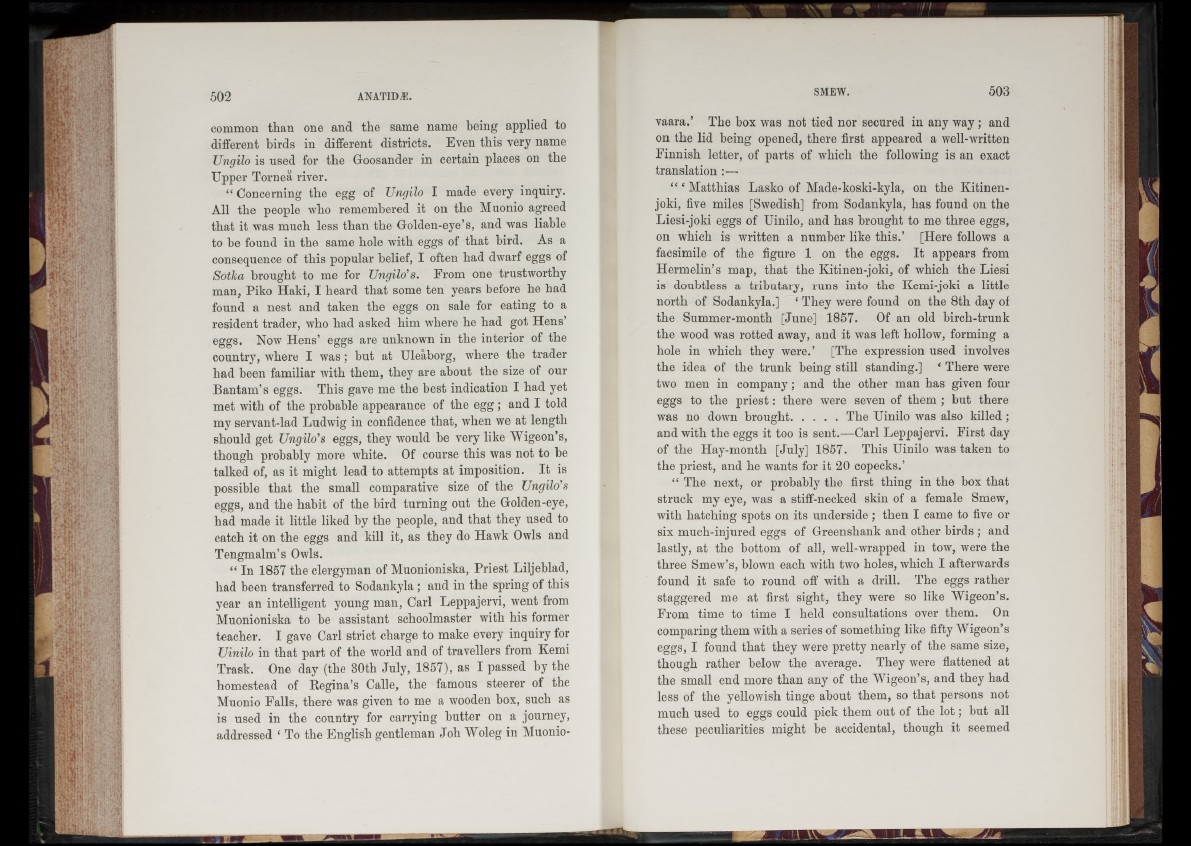
common than one and the same name being applied to
different birds in different districts. Even this very name
Ungilo is used for the Goosander in certain places on the
Upper Tornea river.
“ Concerning the egg of Ungilo I made every inquiry.
All the people who remembered it on the Muonio agreed
that it was much less than the Golden-eye’s, and was liable
to be found in the same hole with eggs of that bird. As a
consequence of this popular belief, I often had dwarf eggs of
Sotka brought to me for Ungilo1 s. From one trustworthy
man, Piko Haki, I heard that some ten years before he had
found a nest and taken the eggs on sale for eating to a
resident trader, who had asked him where he had got Hens’
eggs. Now Hens’ eggs are unknown in the interior of the
country, where I was ; but at Uleaborg, where the trader
had been familiar with them, they are about the size of our
Bantam’s eggs. This gave me the best indication I had yet
met with of the probable appearance of the egg; and I told
my servant-lad Ludwig in confidence that, when we at length
should get Ungilo’s eggs, they would be very like Wigeon’s,
though probably more white. Of course this was not to be
talked of, as it might lead to attempts at imposition. It is
possible that the small comparative size of the Ungilo’s
eggs, and the habit of the bird turning out the Golden-eye,
had made it little liked by the people, and that they used to
catch it on the eggs and kill it, as they do Hawk Owls and
Tengmalm’s Owls.
“ In 1857 the clergyman of Muonioniska, Priest Liljeblad,
had been transferred to Sodankyla ; and in the spring of this
year an intelligent young man, Carl Leppajervi, went from
Muonioniska to be assistant schoolmaster with his former
teacher. I gave Carl strict charge to make every inquiry for
Uinilo in that part of the world and of travellers from Kemi
Trask. One day (the 30th July, 1857), as I passed by the
homestead of Begina’s Calle, the famous steerer of the
Muonio Falls, there was given to me a wooden box, such as
is used in the country for carrying butter on a journey,
addressed ‘ To the English gentleman Joh Woleg in Muoniovaara.’
The box was not tied nor secured in any way ; and
on the lid being opened, there first appeared a well-written
Finnish letter, of parts of which the following is an exact
translation :—
“ ‘ Matthias Lasko of Made-koski-kyla, on the Kitinen-
joki, five miles [Swedish] from Sodankyla, has found on the
Liesi-joki eggs of Uinilo, and has brought to me three eggs,
on which is written a number like this.’ [Here follows a
facsimile of the figure 1 on the eggs. It appears from
Hermelin’s map, that the Kitinen-joki, of which the Liesi
is doubtless a tributary, runs into the Kemi-joki a little
north of Sodankyla.] ‘ They were found on the 8th day of
the Summer-month [June] 1857. Of an old birch-trunk
the wood was rotted away, and it was left hollow, forming a
hole in which they were.’ [The expression used involves
the idea of the trunk being still standing.] ‘ There were
two men in company ; and the other man has given four
eggs to the priest: there were seven of them ; but there
was no down brought.............The Uinilo was also killed ;
and with the eggs it too is sent.—Carl Leppajervi. First day
of the Hay-month [July] 1857. This Uinilo was taken to
the priest, and he wants for it 20 copecks.’
“ The next, or probably the first thing in the box that
struck my eye, was a stiff-necked skin of a female Smew,
with hatching spots on its underside ; then I came to five or
six much-injured eggs of Greenshank and other birds ; and
lastly, at the bottom of all, well-wrapped in tow, were the
three Smew’s, blown each with two holes, which I afterwards
found it safe to round off with a drill. The eggs rather
staggered me at first sight, they were so like Wigeon’s.
From time to time I held consultations over them. On
comparing them with a series of something like fifty Wigeon’s
eggs, I found that they were pretty nearly of the same size,
though rather below the average. They were flattened at
the small end more than any of the Wigeon’s, and they had
less of the yellowish tinge about them, so that persons not
much used to eggs could pick them out of the lo t; but all
these peculiarities might be accidental, though it seemed